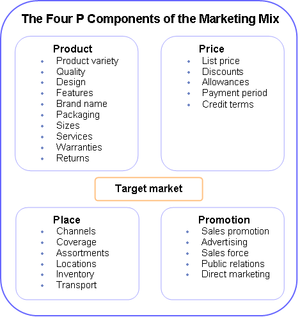Marketing
| Marketing |
|---|
| See also |
Marketing according to American Marketing Association is an organizational function and a set of processes for creating, communicating, and delivering value to customers and for managing customer relationship in ways that benefit the organization and its stakeholders. Marketing efforts are focused on providing products and services causing satisfaction of customers. Understanding what customers need is the most important task of company managers. Marketing always begins and ends with customer.
Marketing may be defined in several ways, depending on its role in relation to the strategic position on competitive market. Philip Kotler is recognized as the originator of the most recent developments in the field of marketing. He defines marketing as the science and art of exploring, creating, and delivering value to satisfy the needs of a target market at a profit. Marketing identifies unfulfilled needs and desires. It defines, measures and quantifies the size of the identified market and the profit potential. It pinpoints which segments the company is capable of serving best and it designs and promotes the appropriate products and services. It is also the means by which an organization communicates to, connects with, and engages with its customers to convey the value of and ultimately sell its products and services.
Major functions of marketing
Marketing is a managerial and social process by which company create, offer and sell products of value for its customers. Basic functions of marketing are:
- exchange functions – all companies are buying and selling to market their merchandise. It includes buying – selecting suppliers, obtaining raw materials to make products and knowing how much merchandise to keep on hand. In addition, selling – it creates possession utility by transferring the title of a product from seller to customer.
- facilitating functions – help the other functions take place. It consists of financing – helps at all stages of marketing. To buy raw materials, manufacturers often receive credit from suppliers or borrow from banks. Retailers provide financing to customers. Standardizing – sets uniform specifications for products or services, grading – it classifies product by size and quality, usually it is connected with sorting process, risk taking, and gathering market information – is needed for making all marketing decisions.
- physical distribution functions – they involve the flow of goods from producers to customers. Transportation and storage provide time and place utility and require very careful management of inventory. It is connected with transporting – involves selecting a mode of transport that provides an acceptable deliver schedule at an acceptable price. What is more, storing goods is often necessary to sell them at the best selling time.
Marketing involves other related activities as well. All mentioned functions are essential if marketing process is to be effective.
Fundamentals of marketing approach to management
Key success factors in marketing approach in company are:
- market orientation,
- fulfilling customer expectations and perceptions,
- effective internal organization,
- high competences of personnel.
See also:
References
- Alsem K.J., (2007). Strategic Marketing: An Applied Perspective, New York, N.Y.: McGraw-Hill
- Ambler, T., Bhattacharya, C. B., Edell, J., Keller, K. L., Lemon, K. N., & Mittal, V. (2002). Relating brandand customer perspectives on marketing management. Journal of Service Research, 5(1), 13-25.
- Cravens, D. W., & Piercy, N. (2006). Strategic marketing (Vol. 7). New York: McGraw-Hill.
- Kotabe, M., & Helsen, K. (1998). Global marketing management. New York.
- Kotler P., (2000). Marketing Management, Prentice Hall, Millennium Edition
- Kotler P., & Armstrong, G. (2010). Principles of marketing. Pearson education.
- Peter J.P., Donnelly Jr J., (2003). Marketing Management: knowledge and skills, McGraw-Hill/Irwin
Author: Maja Pająk
